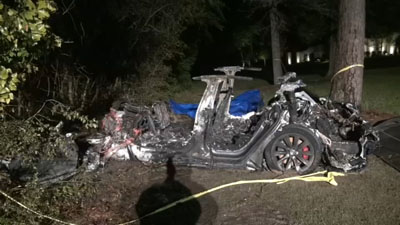The National Transportation Safety Board (NTSB) confirmed Feb. 8 its investigation into an April 2021 fatal crash involving a Tesla Model S in Texas found no indications the vehicle was operating on Autopilot at the time of the incident.
Instead, the probable cause of the crash was determined to be the driver’s excessive speed, alcohol impairment and inability to maintain control of the vehicle.
Two men died in the accident, which caused the Model S to burst into flame. The victims were 69-year-old engineer Everett Talbot and 59-year-old Dr. William Varner. One man was found in the front passenger seat, while the other was found in the back seat.
Following the crash, Harris County Pct. 4 Constable Mark Herman told reporters investigators were “100% certain” there was no one in the Model S’ driver’s seat when it crashed. This prompted widespread coverage from numerous media outlets, with several immediately declaring the fatal incident a “driverless” crash.
“They are 100% certain that no one was in the driver seat driving that vehicle at the time of impact. They are positive… Several of our folks are reconstructionists, but they feel very confident just with the positioning of the bodies after the impact that there was no one driving that vehicle,” Herman told journalists. He later noted a search warrant had been executed on Tesla to secure data about the incident.
There were immediate issues with the idea of a fatal Tesla Autopilot crash. For one, the absence of lane markings in the area’s streets meant Autopilot could not have been engaged. Traffic-Aware Cruise Control could only go up to 30 mph in the area as well; the Model S accelerated to 67 mph before it crashed.
Other details, such as allegations firefighters had to call Tesla for help with an uncontrollable fire, were debunked by the the Woodlands Township fire chief a few days after the incident made international news.
The findings of the NTSB have revealed the fatal accident did not involve Autopilot at all. The agency noted a review of the data from the crash showed “no use of the Autopilot system at any time during this ownership period of the vehicle, including the time frame up to the last transmitted timestamp on April 17, 2021.”
The agency also said the probable cause of the crash was the “driver’s excessive speed and failure to control his car, due to impairment from alcohol intoxication in combination with the effects of two sedating antihistamines, resulting in a roadway departure, tree impact and post-crash fire.”
The NTSB further noted “the available evidence suggests that the driver was seated in the driver’s seat at the time of the crash and moved into the rear seat” and “it was not possible to determine whether the doors were manually operational following the power loss.”
These conclusions are in line with footage retrieved from the owner’s home, which showed the driver entering the front seat before driving away.














